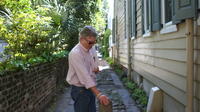Charleston's Alleys and Hidden Passages
Charleston, South Carolina
Trip Type: Walking Tours
Duration: 2 hours
Come explore some of Charleston's most enchanting alleys and hidden passages with Bill Stanton on this approximately 2 hour walking tour.
Distinguished by their beauty, Charleston's alleys occupy spaces that blur the line between public and private areas and offer remarkable insight into the history of the Holy City. These quaint passageways are frequently inaccessible by automobiles and are often overlooked, even by frequent visitors and residents who are more focused on the City's grand homes and famous landmarks. However, walking along these picturesque cobblestone, brick and stone pathways offers an opportunity to step back in time and appreciate more fully Charleston's charms on an intimate and inviting scale.
Distinguished by their beauty, Charleston's alleys occupy spaces that blur the line between public and private areas and offer remarkable insight into the history of the Holy City. These quaint passageways are frequently inaccessible by automobiles and are often overlooked, even by frequent visitors and residents who are more focused on the City's grand homes and famous landmarks. However, walking along these picturesque cobblestone, brick and stone pathways offers an opportunity to step back in time and appreciate more fully Charleston's charms on an intimate and inviting scale.
More About This Activity All Walking Tours →
Come explore some of Charleston's most enchanting alleys and hidden passages with Bill Stanton on this approximately 2 hour walking tour.
Distinguished by their beauty, Charleston's alleys occupy spaces that blur the line between public and private areas and offer remarkable insight into the history of the Holy City. These quaint passageways are frequently inaccessible by automobiles and are often overlooked, even by frequent visitors and residents who are more focused on the City's grand homes and famous landmarks. However, walking along these picturesque cobblestone, brick and stone pathways offers an opportunity to step back in time and appreciate more fully Charleston's charms on an intimate and inviting scale.This tour starts at the Old Exchange and Provost Dungeon and proceeds to visit several attractions in Charleston's Historic District including, but not limited to: the picturesque pastel houses on Rainbow Row; Elliott Street; Poinsett's Tavern; the Washington-Heyward House; the DuBose Heyward House; Longitude Lane, one of the original “streets” of the Old Walled City; a 1750 white building built by slaves for slaves; Stoll's Alley once called a ”dirty, narrow little lane in the lower part of the city” by none other than the New York Times in 1894; St. Michael's Alley- adjacent to St. Michael's Church; Philip Simmons' “Cross and Egret Gate”; the Dock St. Theater and French Huguenot Church; St. Philip's Church (brown); Philadelphia Alley, or Duelers' Alley; Unity Alley; McCrady's Tavern (Restaurant) where George Washington feasted in the original Long Room with the Society of Cincinnati in 1791.
Distinguished by their beauty, Charleston's alleys occupy spaces that blur the line between public and private areas and offer remarkable insight into the history of the Holy City. These quaint passageways are frequently inaccessible by automobiles and are often overlooked, even by frequent visitors and residents who are more focused on the City's grand homes and famous landmarks. However, walking along these picturesque cobblestone, brick and stone pathways offers an opportunity to step back in time and appreciate more fully Charleston's charms on an intimate and inviting scale.This tour starts at the Old Exchange and Provost Dungeon and proceeds to visit several attractions in Charleston's Historic District including, but not limited to: the picturesque pastel houses on Rainbow Row; Elliott Street; Poinsett's Tavern; the Washington-Heyward House; the DuBose Heyward House; Longitude Lane, one of the original “streets” of the Old Walled City; a 1750 white building built by slaves for slaves; Stoll's Alley once called a ”dirty, narrow little lane in the lower part of the city” by none other than the New York Times in 1894; St. Michael's Alley- adjacent to St. Michael's Church; Philip Simmons' “Cross and Egret Gate”; the Dock St. Theater and French Huguenot Church; St. Philip's Church (brown); Philadelphia Alley, or Duelers' Alley; Unity Alley; McCrady's Tavern (Restaurant) where George Washington feasted in the original Long Room with the Society of Cincinnati in 1791.
« Go Back

